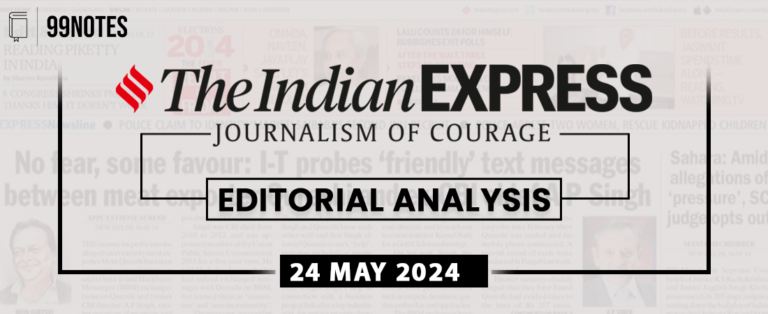12 Feb 2024 : Indian Express Editorial Analysis
Indian Express Editorial Analysis
12-February-2024
1. CLASSROOM VS COACHING
| Topic: GS2 – Social Justice – Education This topic is relevant for both Prelims and Mains in the context of understanding of the complexities within the Indian education system, aligning with the exam’s multidisciplinary approach and the need for a comprehensive understanding of contemporary socio-political issues. |
| Context: |
|
More about the news:
Impact of Unregulated Coaching Culture:
- A concerning trend has emerged where students are leaving traditional schooling after Class X to join “dummy schools” that admit them without requiring attendance, facilitating enrollment in coaching centers to crack exams like CUET.
- This shift has led to a diminishing value of formal education, raising questions about the government’s decision to give weightage to board exam results in competitive exam applications, potentially jeopardizing the future of high school education.
Coaching Centers vs. Schools:
- The failure of policymakers to adequately support students beyond school has allowed coaching centers to become parallel systems, exemplified by institutions like Kota, entrenched in Indian society for over three decades.
- While the National Education Policy emphasizes holistic development, mental health, and understanding, the coaching culture neglects these aspects, pushing children away from classrooms into high-pressure coaching environments, often with parental support.
Addressing Mental Health and Well-being:
- The coaching culture fails to address crucial aspects of mental health and well-being.
- Students suffer from unseen conditions like anxiety, and the lack of downtime for sleep and social interaction affects long-term personality development.
- Coaching centers, focused solely on exam preparation, do not provide the nurturing and supportive environments necessary for healthy adolescent development.
Redefining the Role of Education:
- Education in India must redefine itself to cater to the diverse social and economic landscape, addressing the needs and aspirations of all children.
- True education imparts values and sets goals, aligning with societal expectations to reduce stress and foster emotional stability.
- However, the current emphasis on coaching perpetuates false expectations and stress among students, hindering true learning and innovation required for human flourishing.
Promoting Agency and Innovation:
- To foster a truly inclusive and innovative educational environment, the focus must shift from coaching to empowering students with agency, responsibility, and sensitivity.
- A shared vision emphasizing well-being as the primary goal of education is essential, guiding students to become purposeful, reflective, and responsible individuals capable of creating a better future.
Conclusion:
- The obsession with coaching undermines the development of new ideas, approaches, and research vital for societal progress.
- It is imperative to prioritize holistic education and innovation to nurture the potential of our youth and build a brighter future for generations to come.
| What was The Need to Regulate Coaching Centres in India? |
For ex- 28 cases of student suicides were reported in 2023 alone from Kota- the coaching capital for engg. and medical exams.
For ex- Recent fines imposed on UPSC coaching centres for making false claims.
For ex- Kota is termed as KOTA FACTORY.
For ex- Inapplicability of Consumer Protection Act for the coaching industry. |
| PYQ: National Education Policy 2020 is in conformity with the Sustainable Development Goal-4 (2030). It intends to restructure and reorient education system in India. Critically examine the statement. (250 words/15m) (UPSC CSE (M) GS-2 2020) |
| Practice Question: Examine the impact of the coaching culture on the Indian education system and its implications for student welfare and societal development. (150 words/10 m) |
2. Securing the sea lanes
| Topic: GS3 – Internal Security – Security challenges and their management in border areas This topic is relevant for both Prelims and Mains in the context of India’s geopolitical positioning, maritime security, and defense strategies. |
| Context: |
|
More about the news:
Challenges to Maritime Security:
- Presently, India faces critical challenges to its maritime security, exemplified by the perilous condition of vital sealanes due to escalating attacks by groups like the Houthis in Yemen.
- Reluctance among shipping companies to utilize traditional routes like the Red Sea and the Suez Canal amplifies concerns, leading to increased insurance rates and economic repercussions.
- Despite the global impact, responses have been limited, leaving India, a maritime nation, in a defensive stance.
Need for Strategic Naval Assets:
- To address these challenges effectively, there’s a pressing need for strategic naval assets tailored to modern maritime threats.
- The acquisition of a third aircraft carrier is imperative, albeit with a renewed strategic outlook.
- Unlike existing carriers designed primarily for sea control, a future carrier must possess power projection capabilities, capable of influencing political decisions and safeguarding national interests.
Utilization of Naval Diplomacy:
- The strategic deployment of naval assets can significantly enhance India’s diplomatic leverage on the global stage.
- Noteworthy examples include the presence of the USS Gerald Ford off Lebanon during regional conflicts, demonstrating the deterrent effect of naval power in crisis management.
- Similarly, Indian initiatives, complemented by a formidable aircraft carrier fleet, can bolster diplomatic endeavors and protect national interests in critical regions.
Future Role of Indian Navy:
- In envisioning India’s role as a regional power in 2047, the Indian Navy assumes paramount importance in safeguarding maritime interests and contributing to global stability.
- A proactive approach, characterized by power projection and regional security assurances, necessitates a paradigm shift from defensive postures to proactive engagements.
- Investment in advanced naval capabilities, including power projection aircraft carriers, is essential to uphold India’s maritime sovereignty and counter emerging threats effectively.
Conclusion:
- As India progresses towards becoming a global economic powerhouse, the evolution of its naval capabilities is imperative to address contemporary maritime challenges and shape future geopolitical dynamics.
- Strategic investments in naval assets, coupled with proactive diplomatic engagements, will position India as a pivotal maritime player, ensuring regional security and safeguarding national interests in an increasingly contested maritime domain.
| What are the Initiatives Taken by India to Enhance Maritime Security? |
|
| PYQ: Consider the following in respect of Indian Ocean Naval Symposium (IONS). (2017) 1) Inaugural IONS was held in India in 2015 under the chairmanship of the Indian Navy. 2) IONS is a voluntary initiative that seeks to increase maritime co-operation among navies of the littoral states of the Indian Ocean Region. Which of the above statements is/are correct? (a) 1 only (b) 2 only (c) Both 1 and 2 (d) Neither 1 nor 2 Ans: (b) |
| Practice Question: Discuss the strategic challenges and future naval requirements for India in the context of evolving geopolitical dynamics and maritime security threats. (250 words/15 m) |
For Enquiry

13 February 2024 : The Hindu Editorial Notes PD

13 Feb 2024 : Indian Express Editorial Analysis

13 February 2024 : PIB Summary for UPSC

12 Feb 2024 : Daily Current Affairs Quiz

12 Feb 2024 : Daily Answer Writing

12 Feb 2024 : Daily Current Affairs

12 Feb 2024 : Indian Express Editorial Analysis

12 February 2024 : The Hindu Editorial Notes PDF

12 February 2024 : PIB Summary for UPSC

10 Feb 2024 : Daily Current Affairs Quiz
Feb 2024 The Hindu 13 February 2024 : The Hindu Editorial Notes PD The Hindu Editorial
13-February-2024
1. A global alliance to bridge the gender equity gap
Topic:…
Indian Express 13 Feb 2024 : Indian Express Editorial Analysis Indian Express Editorial Analysis
13-February-2024
1. A science for us
Topic: GS2 – Governance…
feb 2024 PIB 13 February 2024 : PIB Summary for UPSC PIB Summary for UPSC
13-February -2024
1. Union Minister G Kishan Reddy inaugurate regional centre…
Daily Quiz 12 Feb 2024 : Daily Current Affairs Quiz 12 Feb 2024 : Daily Quiz…
mains answer writing 12 Feb 2024 : Daily Answer Writing Mains Answer Writing
12-February-2024
Q1) “Water scarcity threatens economic and social gains…
Daily Current Affairs 12 Feb 2024 : Daily Current Affairs Daily Current Affairs
12-February-2024- Top News of the Day
1. Great Indian Bustards give Nandyal a…
Indian Express 12 Feb 2024 : Indian Express Editorial Analysis Indian Express Editorial Analysis
12-February-2023
1. CLASSROOM VS COACHING
Topic: GS2 – Social…
Feb 2024 The Hindu 12 February 2024 : The Hindu Editorial Notes PDF The Hindu Editorial
12-February-2024
1. A privileged strategic partnership, without a gulf
Topic:…
feb 2024 PIB 12 February 2024 : PIB Summary for UPSC PIB Summary for UPSC
12-February -2024
1. Birth anniversary of Swami Dayanand Saraswati
Topic:…
Daily Quiz 10 Feb 2024 : Daily Current Affairs Quiz 10 Feb 2024 : Daily Quiz…


